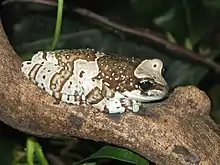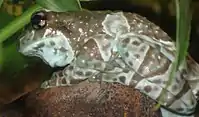| Mission golden-eyed tree frog | |
|---|---|
 | |
| Adult | |
| Scientific classification | |
| Domain: | Eukaryota |
| Kingdom: | Animalia |
| Phylum: | Chordata |
| Class: | Amphibia |
| Order: | Anura |
| Family: | Hylidae |
| Genus: | Trachycephalus |
| Species: | T. resinifictrix |
| Binomial name | |
| Trachycephalus resinifictrix (Goeldi, 1907) | |
| Synonyms | |
|
Phrynohyas resinifictrix | |
The Mission golden-eyed tree frog[2] or Amazon milk frog (Trachycephalus resinifictrix) is a large species of arboreal frog native to the Amazon Rainforest in South America. It is sometimes referred to as the blue milk frog due to a sticky, milk-like substance that they produce when feeling threatened. It was first discovered along the Maracanã River in Brazil. This species was previously within the genus Phrynohyas, which was recently synonymized with Trachycephalus.[1]
Description
These frogs are fairly large, reaching sizes of 2.5 to 4.0 in (6.4 to 10.2 cm) in length. Adult frogs are light grey in colour with brown or black banding, while juveniles will exhibit stronger contrasts. As they age, their skin develops a slightly bumpy texture. Their blood tends to be a shade of blue which can be shown through their skin, most boldly in the mouth area and toe pads.
The "milk" in the common name comes from the milky fluid these frogs excrete when stressed.
%252C_CMN.jpg.webp) Adult
Adult Amazon milk frog – Trachycephalus resinifictrix
Amazon milk frog – Trachycephalus resinifictrix
Habitat
Mission golden-eyed tree frogs inhabit humid rainforest regions. They often inhabit vegetation which extends over permanent, slow-moving water sources.
In captivity
Trachycephalus resinifictrix is commonly found in captivity. They are relatively easy to care for, but require a significant amount of space, humidity, and regular enclosure maintenance to ensure a clean healthy environment for the frog.[3][4] In the wild, they live in temperatures around 21–30 °C,[3] and thus in captivity prefer a similar ambient temperature.
References
- 1 2 Enrique La Marca, Claudia Azevedo-Ramos, Robert Reynolds, Luis A. Coloma, Santiago Ron (2010). Trachycephalus resinifictrix. In: IUCN 2012. IUCN Red List of Threatened Species. Version 2012.2. www.iucnredlist.org.
- ↑ "Amphibian Species of the World 6.2". American Museum of Natural History. Retrieved 3 January 2024.
- 1 2 Josh's Frogs: Amazon Milk Frog Care
- ↑ Amphibian Care: Amazon Milk Frog
External links
 Media related to Trachycephalus resinifictrix at Wikimedia Commons
Media related to Trachycephalus resinifictrix at Wikimedia Commons
